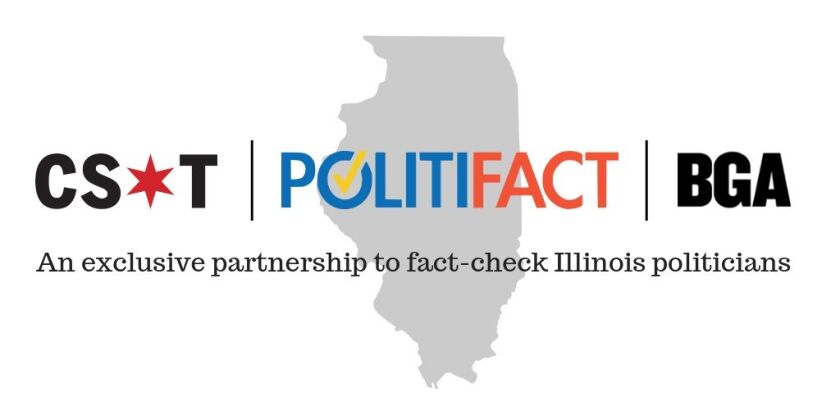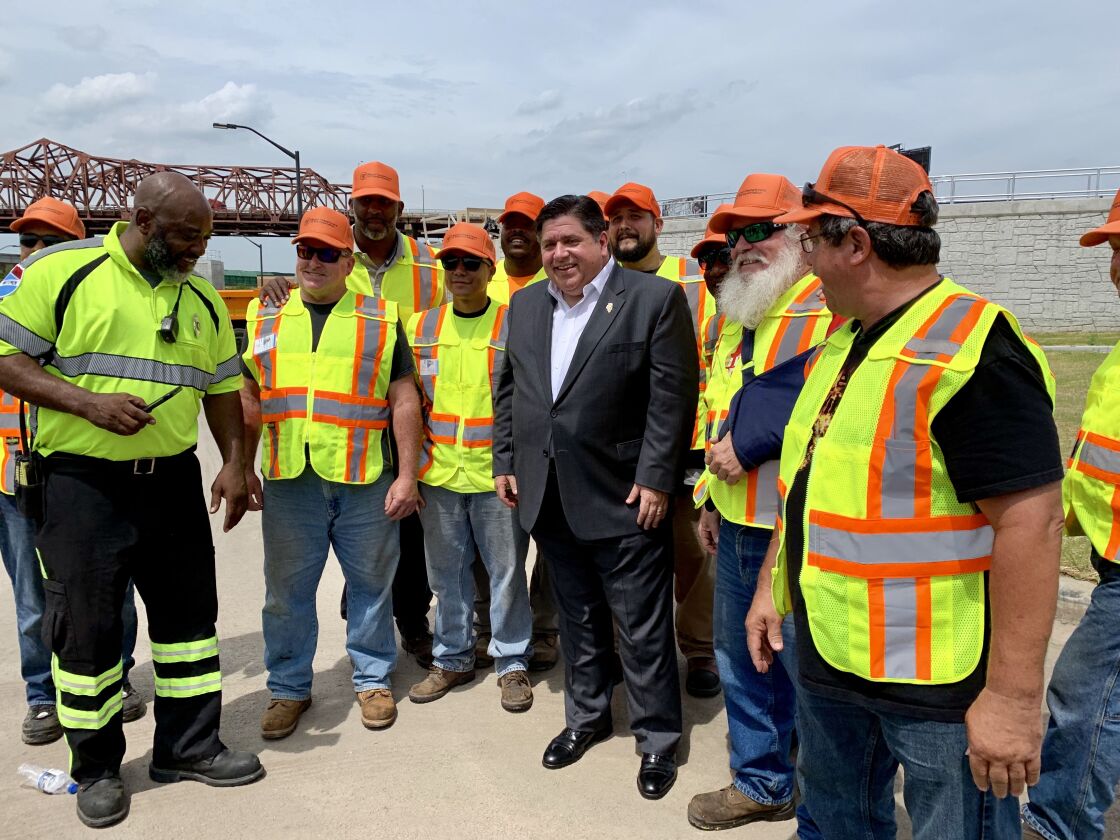During his mostly Downstate tour to tout Illinois’ first capital construction program in a decade, Gov. J.B. Pritzker at each stop has emphasized the local benefits of his $45 billion infrastructure plan, one he says is ultimately fair to the more rural areas that didn’t strongly back his election bid.
Asked during press scrums about whether districts represented by Republicans were getting their fair share, Pritzker responded with this:
“The fact is that a majority of the money, of course, from the infrastructure bill goes to Downstate Illinois. As you know, the many roads, the miles of roads all across the state, the bridges, the significant investment necessary is in mostly Downstate Illinois and although there are Democrats in districts in this area and across Downstate Illinois, most of that is represented by Republican representatives and senators, and I’m very much in favor of fairness here. I want to make sure that we’re making the investments that are necessary.”
The governor also said universities are mostly located in Republican-led districts and will see hundreds of millions of dollars in funding for capital improvements under the plan.
Pritzker’s comments reminded us of a related issue we examined earlier this year.
We rated Pants on Fire! a claim from a central Illinois Republican House member that Chicago is “often bailed out” by the rest of the state’s taxpayers. That fact-check dealt largely with what Chicago gets back in overall state funds, and not just transportation dollars, which make up the bulk of Pritzker’s capital bill. So we decided to check whether the same held true there as well and for the plan overall.
Past practices support part of Pritzker’s point
One of the earliest revelations about the infrastructure plan was that Democrats were getting about twice as much money as Republicans for so-called “member initiatives,” commonly known as pork, even though the measure — and the tax and fee increases that help fund it — received bipartisan support. When asked about that on his tour, Pritzker pivoted to the broader argument that the overall plan was fair.
To that point, member initiative money, totaling about $582 million, makes up just 1.3% of the infrastructure program. Democrats in the Illinois Senate are set to receive about $6 million for pet projects in their districts, while their counterparts in the House get $3 million.
However, Pritzker’s specific claim about where the rest of the funding will go under this plan is not yet possible to pin down based on our analysis.
Pritzker spokeswoman Jordan Abudayyeh responded to our inquiry not with details from a specific state plan but rather with some math and historical perspective, starting with the fact that the governor’s program dedicates 74% of funding to transportation projects. Well more than half of that, the summary of his plan details, is slated to go to roads and bridges.
“He was focused on roads and universities,” Abudayyeh said in an email. “Downstate roads make up the vast majority of the state’s roads and bridges.
“Of Illinois’ roughly 16,000 miles of IDOT (Illinois Department of Transportation) roadways, 83% are located Downstate,” she continued. “Historically, the traditional distribution of road funds has been approximately 55% going to Downstate projects, with the remaining 45% going [to] non-Downstate projects.”
While that statement dealt with transportation issues, neither Pritzker nor anyone in his office provided the information needed to back up the claim about the overall allocation of infrastructure money under the plan. So we won’t be rating it at this time.
Although Pritzker was clear in making his assertion about funding under the bill, even the final plan for roads and bridges isn’t set in stone. IDOT is still conducting studies to determine how transportation funds will be spent, Abudayyeh said. The department is required to produce an annual report detailing how it plans to invest transportation dollars in highway projects slated for the current fiscal year and five years out. But this year’s project report — now injected with billions of additional dollars through Pritzker’s plan — won’t be released until later this summer or early fall, according to Abudayyeh.
While there is no final list of roads projects for his capital plan, past state funding practices appear to support Pritzker’s argument as it pertains to those projects.
Experts we spoke with confirmed the historic 55/45 funding split Pritzker’s office used to defend his claim, noting it’s been common practice for decades even though it isn’t prescribed by state law.
It “has always been kind of a gentleman’s agreement more than any hard-and-fast rule,” according to Jeremy Glover, a transportation expert at the Metropolitan Planning Council in Chicago.
Our analysis of last year’s IDOT report bears out that trend. Estimated funds for projects in Cook County and its five collars comprised 41% of the department’s allocations for state roads and bridges over the six-year period.
But as we said, while Pritzker may be right when it comes to highways, he made a far more sweeping claim about infrastructure funding overall, which has not yet been backed up with hard numbers. Downstate may indeed end up receiving more than half the road and bridge funds, which make up $25 billion in the plan, but that still leaves billions unaccounted for that are not designated geographically in his summary and could tip the balance either way.
Known knowns and known unknowns
Besides roads and bridges, Pritzker’s plan indicates how a few other kinds of funds –– for things such as education and mass transit –– will be divvied up by region.
The Regional Transportation Authority, which serves two million riders each weekday in Chicagoland, will receive the bulk of the $4.7 billion allocated for mass transit, for instance. That’s because the region is where most of the state’s mass transit resides.
As Pritzker noted during his remarks, however, Downstate makes out best when it comes to funding for higher education, which totals nearly $3 billion under the plan.
His office’s capital program summary breaks down spending for universities and community colleges across the state. Schools outside of the state’s six-county Chicagoland region are set to receive 63% of the allocations included in that list.
Despite the considerable amount of transportation funding that has not yet been finalized, experts said they expect Pritzker’s claim will be supported when it comes to roads funds after that money is distributed over the course of the capital program.
“It seems to me to be a fairly reasonable prediction based on past distributions and based on what are inevitably going to be the drivers of those (IDOT) formulas,” said John Jackson, a professor emeritus at Southern Illinois University-Carbondale who co-authored a report that found Cook County and the collars receive less back from the state in general revenue funds for every tax dollar they send to Springfield, while Downstate receives more.
“We’ve got a fair number of known unknowables right now,” Jackson noted. But because IDOT applies the same engineering principles to determine infrastructure needs statewide, he said, it’s unlikely the final outcome will differ greatly from the past.
Charles N. Wheeler III, a state budget expert, longtime political reporter and director of the Public Affairs Reporting program at the University of Illinois-Springfield, also said Pritzker’s assessment there was likely fair in dollar terms.
But he said the capital bill’s broader benefits are not so easy to isolate by region.
“I would argue having major universities around the state is beneficial for everybody, having good roadways, good infrastructure to get the trucks out from wherever the headquarters are out around the state, that’s good for everybody,” Wheeler said. “It’s not just something where the total value goes to the place where the particular improvement is located.”
The Better Government Association runs PolitiFact Illinois, the local arm of the nationally renowned, Pulitzer Prize-winning fact-checking enterprise that rates the truthfulness of statements made by governmental leaders and politicians. BGA’s fact-checking service has teamed up weekly with the Sun-Times, in print and online. You can find all of the PolitiFact Illinois stories we’ve reported together here.
Sources
“Illinois Governor Election Results,” New York Times, Jan. 28, 2019
Video: Pritzker media event in Springfield, Illinois Department of Central Management Services, June 28, 2019
Video: Pritzker media event in East St. Louis, Illinois Department of Central Management Services, June 28, 2019
“No, Chicago isn’t ‘often bailed out’ by Illinois taxpayers,” April 7, 2019
“LIGHTFOOT charms on ‘Late Show’ — DEMS’ big piece of capital pie — DURBIN’s ‘worst vote’ — AUSTIN probe,” Politico Illinois Playbook, June 24, 2019
“Inside Illinois lawmakers’ pork-barrel frenzy: Pickleball courts, dog parks and clout,” Chicago Tribune, June 7, 2019
Email interview: Jordan Abudayyeh, Pritzker spokesperson, July 2 & 8, 2019
Capital plan, Office of the Governor, June 28, 2019
Phone interview: Jeremy Glover, transportation associate at the Metropolitan Planning Council, July 9, 2019
Phone interview: John Jackson, visiting professor at the Paul Simon Public Policy Institute and professor emeritus at Southern Illinois University-Carbondale, July 9, 2019
Phone interview: Charles N. Wheeler III, director of the Public Affairs Reporting program at the University of Illinois-Springfield, July 3 & 10, 2019
Phone interview: Christopher Mooney, professor of state politics at the University of Illinois-Chicago, July 2, 2019
Phone interview: P.S. Sriraj, Director of the Urban Transportation Center at the University of Illinois-Chicago, July 8, 2019
Phone interview: Linda Wheeler, former director of planning and programming at IDOT, July 9, 2019







